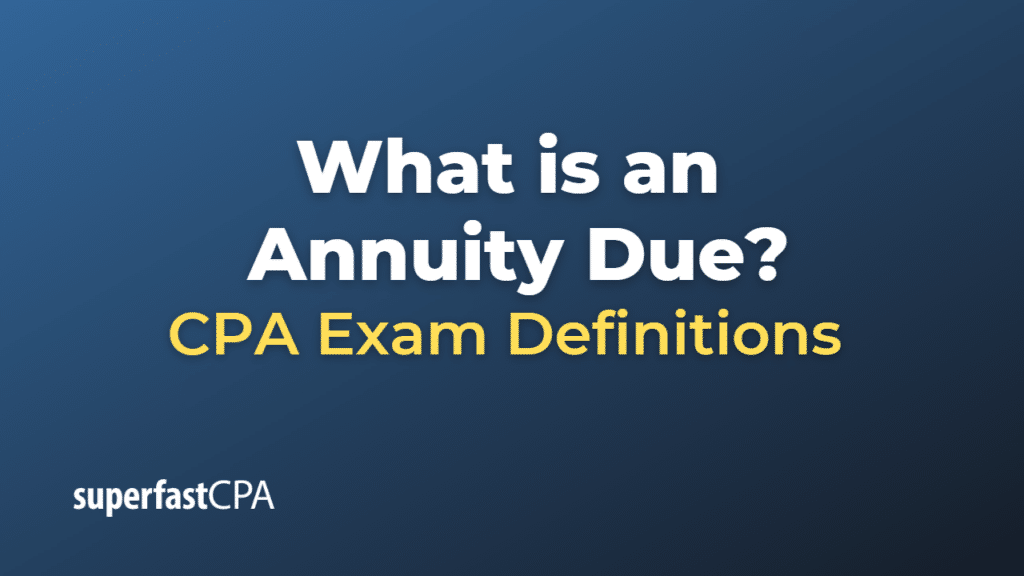Annuity Due
An annuity due is a type of annuity where payments are made at the beginning of each period, rather than at the end, which is the case for a standard (or ordinary) annuity. Annuities are series of equal payments made at equal intervals, such as monthly, quarterly, or annually.
Key Characteristics of an Annuity Due:
- Payments at the Beginning: The most distinguishing feature is that each payment in an annuity due is made at the start of a period. For example, if you have an annual annuity due, and the first payment is due on January 1, 2023, then you will pay on January 1, not December 31.
- Common Examples: Lease payments and rent payments are often examples of annuities due because landlords frequently require payment at the beginning of a rental period. Another example can be insurance premiums where payments are generally made at the beginning of the coverage period.
- Valuation: Because payments are made earlier in an annuity due compared to an ordinary annuity, the present value and future value of an annuity due will be different (generally higher) than that of an ordinary annuity with the same rate and number of periods.
- Relationship with Ordinary Annuity: If you know the present or future value of an ordinary annuity, you can easily find the present or future value of an annuity due by adjusting for the timing difference. Specifically, you’d multiply the ordinary annuity value by (1+r)(1+r), where rr is the discount or interest rate per period.
In summary, the primary difference between an annuity due and an ordinary annuity is the timing of the payments. While ordinary annuities have payments at the end of each period, annuities due have payments at the beginning of each period. This difference in timing affects the valuation of these cash flows.
Example of an Annuity Due
Let’s delve into an example that further illustrates the concept of an annuity due:
Scenario:
Imagine you’re deciding to take a membership at a premium fitness center. The fitness center charges $120 at the beginning of each month as a membership fee. You want to know how much the total payments would be worth in today’s terms if you plan to keep the membership for one year. Assume a discount rate of 6% annually (or 0.5% monthly when divided by 12).
Given:
- C (Monthly membership fee) = $120
- r (Monthly discount rate) = 0.5% or 0.005 in decimal form
- n (Number of months) = 12
Step 1: Calculate the PV of an ordinary annuity.
Using the formula for the PV of an ordinary annuity:
\(\large PV_{\text{ordinary annuity}} = \text{C x } \frac{(1-(1+r))^{-n})}{r} \)
Plugging in the given values:
\(\large PV_{\text{ordinary annuity}} = \text{120 x } \frac{(1-(1+0.005))^{-12})}{0.005} \)
\(PV_{\text{ordinary annuity}} = 1,405.23 \)
Step 2: Adjust for the annuity due.
Since the payments are at the beginning of each month (annuity due), we adjust the ordinary annuity by multiplying it by (1+r):
\(PV_{\text{due}} = PV_{\text{ordinary annuity}} \text{ x (1 + r)} \)
\(PV_{\text{due}} = \text{1,402.23 x (1 + 0.005)} \)
\(PV_{\text{due}} \approx \text{1,412.76} \)
Conclusion:
The present value of the fitness center membership payments, when paid at the beginning of each month, is approximately $1,412.76 given a 6% annual discount rate. This means, in today’s money, you’d be indifferent between paying a lump sum of $1,412.76 now or making 12 monthly payments of $120 at the beginning of each month for the next year, given the discount rate.
This example showcases the primary difference in the valuation of an annuity due compared to an ordinary annuity because of the timing of payments.













